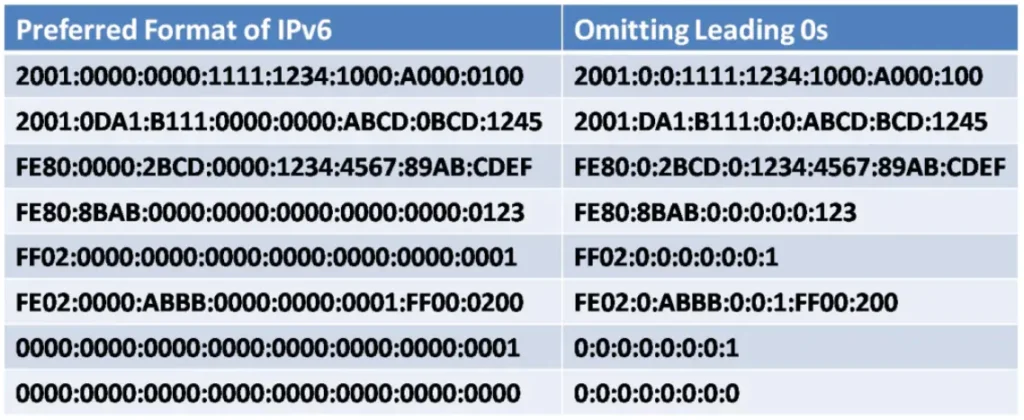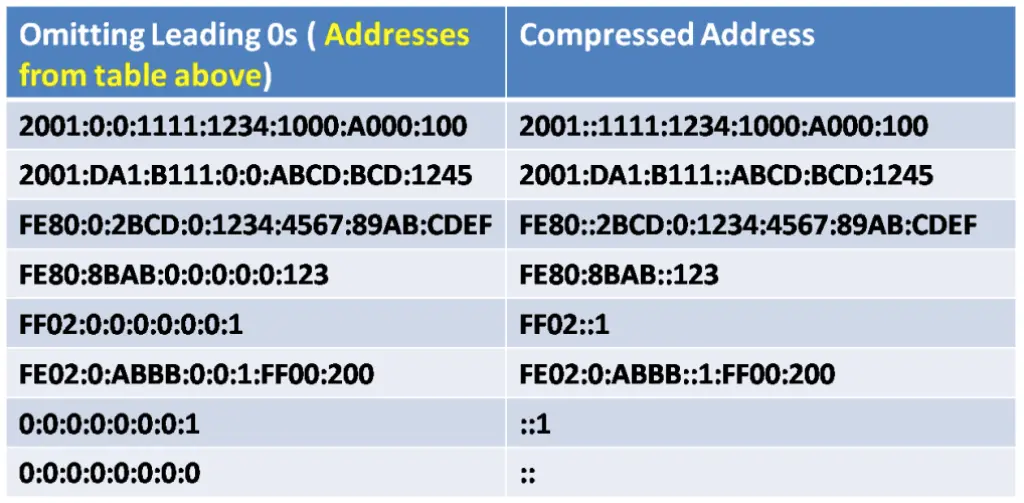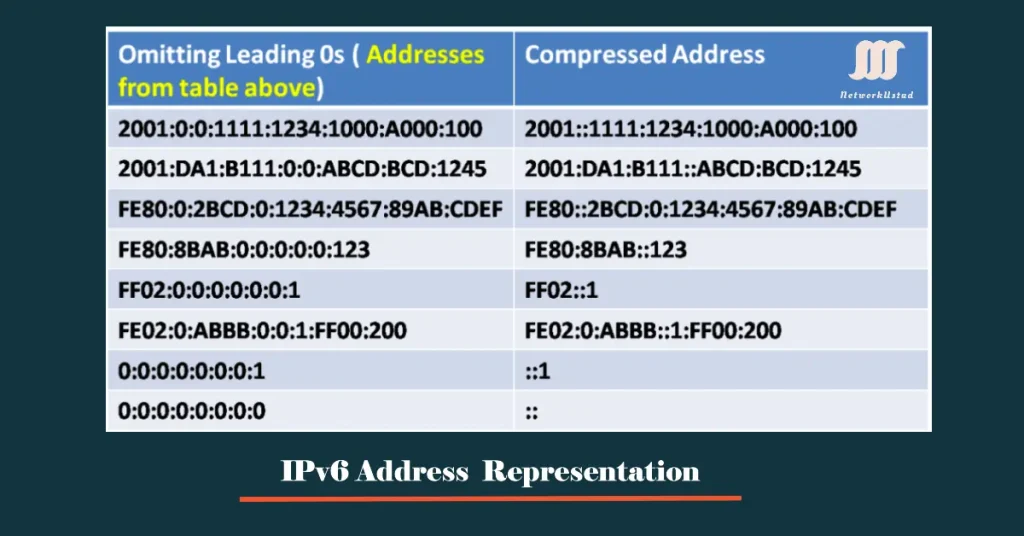IPv6 Address Representation – An Exclusive Explanation
IPv6 addresses are 128 bits and represented as eight groups of four hexadecimal digits each, each group representing 16 bits. The address can be written in both lowercase and uppercase. The preferred format for writing an IPv6 address is x: x: x: x: x: x: x: x, where each “x” is a group of four hexadecimal digits, and each group contains 16 bits. The term used for a group is a hextet. So, each “x” is a single hextet, 16 bits, or four hexadecimal digits.
The range of IPv6 addresses is 0000:0000:0000:0000:0000:0000:0000:0000 to FFFF: FFFF: FFFF: FFFF: FFFF: FFFF: FFFF: FFFF. This expression is in hexadecimal. If we convert one hextet into binary, it should be 16 bits. For example, we have a hextet “0000” that is equal to 0000000000000000 (16 time 0s), and hextet “FFFF” is equal to 1111111111111111 (16 tim1 1s). The following is the primary relationship table of binary, decimal, and hexadecimal.
| Decimal | Binary | Hexadecimal |
| 0 | 0000 | 0 |
| 1 | 0001 | 1 |
| 2 | 0010 | 2 |
| 3 | 0011 | 3 |
| 4 | 0100 | 4 |
| 5 | 0101 | 5 |
| 6 | 0110 | 6 |
| 7 | 0111 | 7 |
| 8 | 1000 | 8 |
| 9 | 1001 | 9 |
| 10 | 1010 | A |
| 11 | 1011 | B |
| 12 | 1100 | C |
| 13 | 1101 | D |
| 14 | 1110 | E |
| 15 | 1111 | F |
The ideal method of representing IPv6 addresses is groups of eight hextet (32 hexadecimal digits). However, there are two rules we can apply to reduce the number of digits needed to represent an IPv6 address. The preferred format for representing an IPv6 address is the following.
2001 : 0000 : 0000 : 1111 : 1234 : 1000 : A000 : 0100
2001 : 0DA1 : B111 : 0000 : 0000 : ABCD : 0BCD : 1245
FE80 : 0000 : 2BCD : 0000 : 1234 : 4567 : 89AB : CDEF
FE80 : 8BAB : 0000 : 0000 : 0000 : 0000 : 0000 : 0123
FF02 : 0000 : 0000 : 0000 : 0000 : 0000 : 0000 : 0001
FE02 : 0000 : ABBB: 0000 : 0000 : 0001 : FF00 : 0200
0000 : 0000 : 0000 : 0000 : 0000 : 0000 : 0000 : 0001
0000 : 0000 : 0000 : 0000 : 0000 : 0000 : 0000 : 0000
Shortening IPv6 addresses
There are two rules defined for shortening IPv6 addresses in RFCs 2373 and 5952. The rules are important to understand.
Omitting Leading 0s
Omitting leading 0 is the first rule to reduce the notation of the IPv6 address. The following are the examples to omit any leading 0s (zeros) in any 16-bit section or hextet:
- 0100 can be represented as 100
- 0DA1 can be represented as DA1
- 0123 can be represented as 123
- 0000 can be represented as 0
This rule only omits leading 0s, not trailing 0s. Otherwise, the address would be ambiguous. The table below shows examples of omitting leading 0s from the IPv6 address.

Omit All 0 Segments
The second rule reduces the notation of IPv6 addresses using a double colon (::) that can replace any single, contiguous string of one or more hextet containing all 0s. The double colon (::) can only be used once within an address; otherwise, there would be more than one possible resulting address. For example, if we have an IPv6 address FE02: 0000 : ABBB: 0000: 0000: 0001: FF00: 0200 and we apply the technique like FE02:: ABBB:: 1: FF00: 200. it is not correct. When used with the omitting leading 0s technique, the notation of the IPv6 address can often be greatly reduced. This is commonly known as the compressed format.

Common Mistakes & Examples in IPv6 Address Shortening
1. Using Multiple “::” in a Single Address
The double colon (::) can only be used once to replace the longest consecutive sequence of zeros.
- Mistake:
2001::db8::1
(Two::symbols, which is invalid.) - Correct:
2001:db8::1
(Single::replaces the longest zero sequence.)
2. Failing to Compress the Longest Zero Run
RFC 5952 mandates replacing the longest consecutive zero groups. If multiple runs exist, compress the leftmost longest run.
- Original Address:
2001:0db8:0000:0000:0000:ff00:0042:8329 - Mistake:
2001:db8:0::ff00:42:8329
(Shortened only one zero group instead of three.) - Correct:
2001:db8::ff00:42:8329
(Replaces the longest zero sequence:0000:0000:0000→::.)
3. Incorrectly Truncating Non-Zero Groups
Leading zeros in a group can be removed, but trailing zeros cannot.
- Mistake:
2001:0db8:85a3:0000:0000:8a2e:0370:7334→2001:db8:85a3::8a2e:370:7334
(Truncated0370to370, which is valid. However, if the group was0370, truncating to370is correct. If it was037f, truncating to37fwould be wrong.) - Edge Case:
fe80:0000:0000:0000:0000:0000:0000:0001→fe80::1(Correct).
Mistakenly writingfe80::0:1adds an unnecessary zero.
4. Ambiguous or Invalid Placement of “::”
The :: must replace a full 16-bit zero group (or consecutive groups).
- Mistake:
3ffe:0500:0000:0000:0000:0000:0000:0001→3ffe:500::::1
(Too many colons; invalid syntax.) - Correct:
3ffe:500::1
5. Shortening Non-Consecutive Zeros
:: can only compress consecutive zero groups, not scattered zeros.
- Original Address:
2001:0:0:ff00:0:0:0:1 - Mistake:
2001::ff00::1
(Two::symbols.) - Correct:
2001::ff00:0:0:1
(Compress the leftmost zero run first.)
6. Over-Compressing Single Zero Groups
A single zero group (0000) can be written as 0, but not ::.
- Mistake:
2001:0db8:0:0:1:0:0:1→2001:db8::1::1
(Invalid double::.) - Correct:
2001:db8:0:0:1::1
7. Misrepresenting Special Addresses
Loopback (::1) and unspecified (::) addresses have fixed forms.
- Mistake:
0:0:0:0:0:0:0:1→::::::1
(Invalid colon usage.) - Correct:
::1
Summary of Best Practices
- Use
::once to replace the longest consecutive zero sequence. - Remove leading zeros in groups (e.g.,
0db8→db8). - Keep trailing zeros (e.g.,
abc0staysabc0, notabc). - For equal-length zero runs, compress the leftmost one.
- Always validate shortened addresses with tools like IPv6 Test.
Examples of Valid vs. Invalid Shortening
| Original Address | Invalid Shortening | Correct Shortening |
|---|---|---|
2001:0db8:0000:0000:0000:ff00:0042:8329 | 2001:db8:0::ff00:42:8329 | 2001:db8::ff00:42:8329 |
fe80:0000:0000:0000:0000:0000:0000:0001 | fe80::0:1 | fe80::1 |
3ffe:0500:0000:0000:0000:0000:0000:0001 | 3ffe:500::::1 | 3ffe:500::1 |
0000:0000:0000:0000:0000:0000:0000:0001 | ::0:1 | ::1 |
By avoiding these pitfalls and adhering to RFC 5952 standards, you’ll ensure accurate and unambiguous IPv6 address representation.
Prefix Length Notation
The most left bits of the IPv6 address and the network bits length represented in CIDR format are known as the network prefix. The prefixes in IPv6 are used similarly to the subnet mask of IPv4 addresses. In IPv6, we use a notation similar to the CIDR mask representation in IPv4. The notation values are between 1 and 128 to represent the network bits.
For example, in IPv6 address 2001: ABC8: 1000: 000C: 0000: 0000: 0000: 0001/ 64, 2001: ABC8: 1000: 000C::/64 represents the network prefix and the range for this IP network is from 2001: ABC8: 1000: 000C: 0000: 0000: 0000: 0001/64 to 2001: ABC8: 1000: 000C: ffff: ffff: ffff: ffff/64.
The first three hextet (48 bits ) 2001:ABC8:1000 are the IP version 6 global routing prefix, and the next 16 bits(hextet) “000C ” is used for internal subnetting within an organization, and the last 64 bits are used for internal hosts of the network. The length of the IPv6 prefix is used to recognize how many bits of a Global Unicast IP version 6 address are in the network.
Typically, Network Administrators and engineers choose prefix lengths that are multiples of four. That makes the prefix easier to comprehend without using a subnet calculator. Look at the table below to understand IPv6 Prefix. Each additional 4 in the prefix length moves the network portion of the address one hexadecimal digit to the right.
| Prefix Length | Network Portion | Total Addresses | Remarks |
|---|---|---|---|
| /4 | 2000::/4 | 21242124 | – Reserved for future global unicast allocations. – Example: 2xxx::/4 (where x is variable). |
| /8 | 2000::/8 | 21202120 | – Sub-range of /4 for large-scale allocations (e.g., continental ISPs). |
| /16 | 2001::/16 | 21122112 | – Assigned to regional internet registries (RIRs). |
| /32 | 2001:db8::/32 | 296296 | – Documentation/example prefix (RFC 3849). |
| /48 | 2001:db8:1234::/48 | 280280 | – Standard assignment for organizations (supports 65k subnets). |
| /64 | 2001:db8:1234:5678::/64 | 264264 | – Default subnet size for end networks (SLAAC/DHCPv6). |
| /128 | ::1/128 | 11 | – Loopback address (refers to the device itself). |
Key Notes
- Network Portion:
- For
/4, the first 4 bits are fixed (e.g.,2in hex =0010in binary), and the rest are variable. - Addresses like
2000::/4are part of the global unicast range (2000::/3is standard).
- For
- Total Addresses:
- Calculated as 2(128 − Prefix Length).
- Example: For /4, 2(128 − 4) = 2124.
- Special Cases:
/64is mandatory for SLAAC (Stateless Address Autoconfiguration)./128is a single-host address (e.g.,::1for loopback).
FAQs
-
IPv6 addresses are written in eight groups of four hexadecimal digits separated by colons. This format ensures clarity and consistency.
